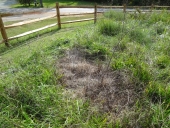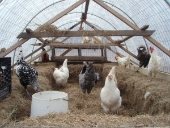Hi All,
Thought I would show our chicken setup so far. We have a little over one year under our belts and have already learned a lot.
We have New Hampshire reds for layers, and Cornish roasters for meat. We love the NH reds and the Cornish Roasters don't seem to have any major health problems yet that we were worrying about. Of course, our chickens are rationed on food a little and they get plenty of exercise. Our flock now consists of 11 NH reds, and 24 Cornish roasters.

We have a portable electric netting fence that so far (touch wood) has protected the flock from predators. We haven't lost a single one using it. We did have them truly free range for awhile, but we lost two to a fox. We improved our range shelters this year. We started off with light weight shelters that were very vulnerable to the winter, and were ultimately destroyed in a fall storm after we moved our chickens to a permanent location for the winter. Now they are heavy, maybe too heavy, but surely wont blow away.

We feed them a combination of conventional feed, kitchen scraps, and now broken clams from the local seafood buyer.
We are also in the process of building a chicken coop/wood shed combination. The chicken coop portion will only be 7x7, while the whole building is 14x14. The coop is for the winter months and brooding. It is built, primarily, with harvested and milled by us, on our property.

We sell our extra eggs roadside, and never have any trouble doing so. We might expand the egg laying flock, if for no other reason, than because we feel bad when we have to tell our customers that we our out.
I think the meat birds are defiantly going to pay for themselves, unless you put a price on our time, then I'm not sure. The eggs are probably cutting it a little more closely.
We might expand to two pasture fences some time.
That's it for now! Sorry about the quality of pictures.









